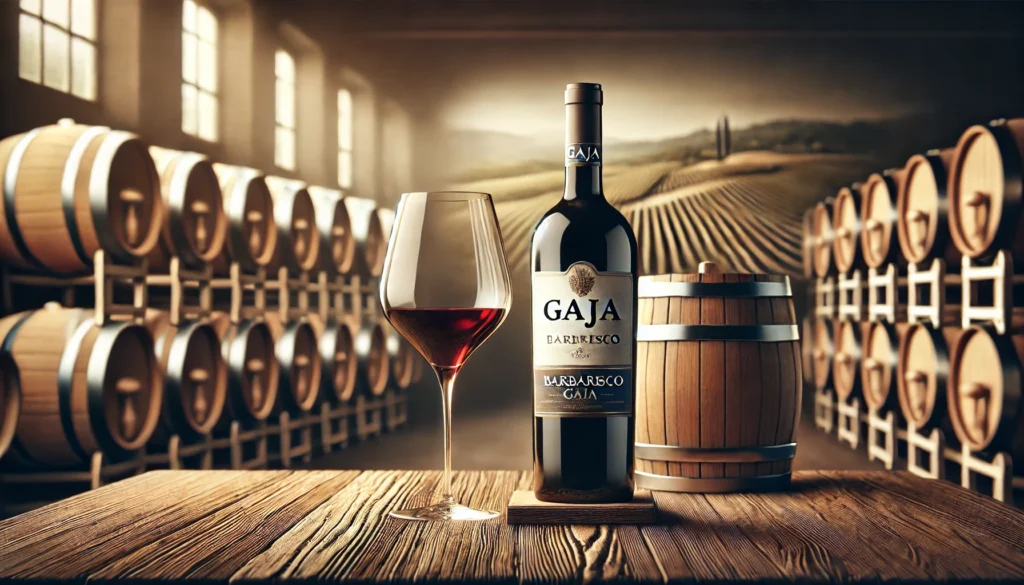When it comes to Italian wine, a few names stand out as true legends, with Gaja being one of the most prestigious and respected. Gaja’s Barbaresco, crafted from the Nebbiolo grape in Italy’s Piedmont region, represents the pinnacle of winemaking artistry, combining the rich heritage of traditional winemaking with modern innovations that have transformed the way the world views Italian wine. Known for its elegance, complexity, and exceptional quality, Barbaresco Gaja has become synonymous with luxury and excellence in the world of fine wines.
In this comprehensive guide, we will explore the history of Gaja, the characteristics of Barbaresco, the winemaking process, and why this wine has earned its place as one of the most coveted labels in the world. Whether you’re a seasoned wine connoisseur or a curious enthusiast, this article will delve into the fascinating world of Barbaresco Gaja and what makes it so extraordinary.
The Legacy of Gaja: A Family Tradition
The Gaja family has been producing wine in the Piedmont region since 1859, when Giovanni Gaja founded the winery. Located in the small village of Barbaresco, the Gaja winery began with a focus on producing high-quality local wines, particularly Barbaresco, using the native Nebbiolo grape. Over the decades, the Gaja family became renowned for their commitment to excellence and their meticulous approach to winemaking.
It was in the 1960s that Angelo Gaja, Giovanni’s great-grandson, took over the family business and transformed it into a global icon of Italian wine. Angelo introduced a number of groundbreaking innovations to the winery, including the use of modern vinification techniques, single-vineyard bottling, and the introduction of French oak barriques for aging, a departure from the traditional large Slavonian oak casks used in the region.
Angelo Gaja’s bold vision and willingness to challenge the status quo helped elevate the quality of Barbaresco to unprecedented levels, establishing the Gaja name as a symbol of luxury and quality. Today, the Gaja family remains at the helm of the winery, with Angelo’s children continuing the tradition of innovation and excellence.
What Is Barbaresco?
Barbaresco is a red wine made from the Nebbiolo grape, grown in the Barbaresco appellation of the Langhe region in Piedmont, northern Italy. Nebbiolo, the same grape used to produce Barolo, is known for its powerful tannins, complex aromas, and ability to age gracefully. Barbaresco wines are often compared to Barolo, as both are produced from Nebbiolo in neighboring regions. However, Barbaresco is often considered more elegant and approachable at a younger age, whereas Barolo is known for its boldness and longevity.
1. The Terroir of Barbaresco
The unique terroir of Barbaresco plays a crucial role in shaping the character of the wine. The appellation is situated on the right bank of the Tanaro River, where the soil is primarily composed of limestone, clay, and sandy marl. This combination of soil types, along with the region’s cooler climate, contributes to the finesse, acidity, and aromatic complexity of Barbaresco wines.
The microclimate of Barbaresco, influenced by the proximity of the river, results in a slightly warmer environment compared to the neighboring Barolo region. This allows the Nebbiolo grapes to ripen more fully, giving Barbaresco wines a softer and more delicate structure compared to the more tannic and robust Barolo wines.
2. Characteristics of Barbaresco Wine
Barbaresco wines are renowned for their elegance, complexity, and balance. The wines typically display a range of aromas and flavors, including red berries, cherries, violets, rose petals, licorice, and earthy undertones such as truffles, tobacco, and leather. As the wine ages, it develops more nuanced flavors, including dried fruits, spices, and forest floor notes.
The tannins in Barbaresco are generally firm but more refined than those found in Barolo, making the wine more accessible in its youth while still capable of aging for decades. The acidity of Barbaresco is another defining feature, giving the wine a bright and lively character that balances its richness and depth.
The Winemaking Process of Barbaresco Gaja
Gaja’s approach to winemaking is a blend of tradition and modernity, with a focus on producing wines that reflect the unique terroir of Barbaresco while incorporating innovative techniques to enhance quality and expression.
1. Vineyard Management
The Gaja family places great emphasis on vineyard management, recognizing that great wine begins in the vineyard. The Nebbiolo grapes used to produce Barbaresco Gaja are grown in carefully selected vineyards, many of which are considered some of the finest in the region. The vineyards are managed with a combination of organic and sustainable practices, ensuring that the vines are healthy and the grapes are of the highest quality.
Gaja is known for its meticulous attention to detail in the vineyard, including low yields, selective harvesting, and careful canopy management to ensure optimal ripeness and flavor concentration in the grapes.
2. Fermentation and Aging
Once harvested, the grapes undergo fermentation in temperature-controlled stainless steel tanks to preserve the purity of the fruit and the natural characteristics of the Nebbiolo grape. Gaja employs both traditional and modern winemaking techniques to enhance the complexity and structure of the wine.
One of Gaja’s most notable innovations is the use of French oak barriques for aging, a departure from the larger Slavonian oak casks traditionally used in the region. The use of smaller barrels allows for greater integration of oak flavors and provides a more refined texture to the wine. Barbaresco Gaja is typically aged in oak for 12 months, followed by additional aging in large oak casks to achieve a perfect balance of fruit, tannins, and acidity.
3. Blending and Bottling
While single-vineyard Barbarescos are a hallmark of Gaja’s portfolio, the winery also produces a classic Barbaresco blend from grapes sourced from multiple vineyards. This blending process allows Gaja to create a wine that reflects the broader characteristics of the Barbaresco region, showcasing the harmony and balance that defines the appellation.
After aging, the wine is bottled and undergoes further maturation in the bottle before it is released to the market. This additional bottle aging ensures that the wine is ready to drink upon release, although Barbaresco Gaja can continue to develop in the bottle for many years, offering even greater complexity with time.
Gaja’s Iconic Barbaresco Wines
Over the years, Gaja has produced several iconic Barbaresco wines that have earned critical acclaim and a devoted following among collectors and wine enthusiasts. Some of the most notable Barbaresco wines from Gaja include:
1. Barbaresco Gaja DOCG
The flagship wine of the Gaja portfolio, Barbaresco Gaja DOCG is a blend of Nebbiolo grapes from several of the estate’s best vineyards. This wine is known for its elegance, structure, and depth, with flavors of red berries, floral notes, and hints of tobacco and spice. It is a wine that embodies the essence of the Barbaresco appellation and is often considered one of the finest examples of Barbaresco available.
2. Costa Russi
Costa Russi is a single-vineyard Barbaresco produced from a prestigious vineyard in the village of Barbaresco. This wine is known for its richness, complexity, and longevity, with intense flavors of dark fruit, licorice, and earthy undertones. Costa Russi is a wine that benefits from extended aging and is highly sought after by collectors.
3. Sorì Tildìn
Sorì Tildìn is another single-vineyard Barbaresco from Gaja, named after Angelo Gaja’s grandmother, Clotilde Rey. The vineyard’s southern exposure allows for optimal ripening of the Nebbiolo grapes, resulting in a wine with concentrated flavors of black cherry, plum, and violet, along with a firm tannic structure that promises long aging potential.
4. Sorì San Lorenzo
Sorì San Lorenzo is considered one of Gaja’s most powerful and structured Barbaresco wines. Produced from a vineyard located in the town of Barbaresco, Sorì San Lorenzo offers intense flavors of dark fruit, leather, tobacco, and spice, with a bold tannic backbone that ensures the wine will continue to evolve for decades.
The Global Impact of Barbaresco Gaja
Gaja’s influence extends far beyond the vineyards of Barbaresco. The winery has played a pivotal role in elevating the global perception of Italian wine, particularly Nebbiolo-based wines from Piedmont. Through Angelo Gaja’s relentless pursuit of quality and his willingness to challenge traditional winemaking practices, the winery has set a new standard for excellence in Italian wine.
1. International Acclaim
Barbaresco Gaja has earned international acclaim for its exceptional quality and consistency. Wine critics, sommeliers, and collectors around the world have praised Gaja’s Barbaresco wines for their complexity, elegance, and ability to age gracefully. The wines have consistently received high scores from publications such as Wine Spectator, Robert Parker’s Wine Advocate, and Decanter, further solidifying Gaja’s reputation as one of the world’s top wine producers.
2. Collector’s Item
Gaja’s Barbaresco wines are highly sought after by collectors, often commanding high prices at auctions and in the retail market. The limited production of single-vineyard Barbarescos, combined with their aging potential, makes them valuable additions to any wine collection. Vintage bottles of Gaja Barbaresco have become prized possessions for wine
enthusiasts who appreciate the craftsmanship and artistry that goes into each bottle.
3. Influence on Winemaking Practices
Angelo Gaja’s innovative winemaking techniques, such as the use of French oak barriques and single-vineyard bottling, have had a lasting impact on the winemaking industry, not only in Piedmont but globally. Many winemakers in Italy and beyond have adopted similar practices, recognizing the value of blending tradition with modern innovation to produce wines of exceptional quality.
Conclusion
Barbaresco Gaja is much more than just a wine; it is a symbol of the Gaja family’s dedication to excellence, innovation, and respect for tradition. With each bottle, Gaja offers a glimpse into the unique terroir of Barbaresco and the artistry that goes into crafting some of the world’s finest wines. Whether you are a seasoned collector or someone new to Italian wines, Barbaresco Gaja is a testament to the timeless beauty and complexity of Nebbiolo.
FAQs
- What is Barbaresco Gaja? Barbaresco Gaja is a renowned wine produced by the Gaja family in the Barbaresco region of Piedmont, Italy, using the Nebbiolo grape.
- How is Barbaresco different from Barolo? Both wines are made from Nebbiolo, but Barbaresco is generally more elegant and approachable at a younger age, while Barolo tends to be bolder and more tannic, requiring longer aging.
- What are the key characteristics of Barbaresco Gaja wines? Barbaresco Gaja wines are known for their complexity, elegance, refined tannins, and flavors of red berries, flowers, tobacco, and earthy undertones.
- How long can Barbaresco Gaja age? Barbaresco Gaja wines have excellent aging potential, with many bottles capable of maturing for 10-30 years or more, depending on the vintage and storage conditions.
- What are Gaja’s most famous single-vineyard Barbaresco wines? Gaja’s most famous single-vineyard Barbaresco wines include Costa Russi, Sorì Tildìn, and Sorì San Lorenzo, each offering unique characteristics and exceptional quality.
- Why is Barbaresco Gaja so highly regarded? Barbaresco Gaja is highly regarded for its meticulous winemaking, the exceptional quality of its vineyards, and the visionary leadership of the Gaja family, which has elevated the reputation of Barbaresco wines on the global stage.







